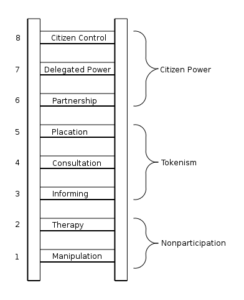Community is Key to UHC

Representatives of the People’s Health Movement attending the WHO Executive Board Meeting in February 2020. Photo credit: John Coonrod
In my 43 years in international development, this was my first visit to the World Health Organization (WHO). I am a coordinator of the Movement for Community-led Development. Until recently, community-led development was not high on the WHO agenda, but now it is moving up. As a newly minted GHC member, I attended the 2020 Executive Board Meeting with one mission – to strengthen the role of communities in achieving Universal Health Coverage – what GHC refers to as the movement to #DemocratizeGlobalHealth.

Arnstein, S.R. (1969), “A Ladder of Citizen Participation”, Journal of the American Planning Association, 35 (4): 216–224, doi:10.1080/01944366908977225
To achieve the 2030 health goals (Sustainable Development Goal 3), The Global Action Plan (GAP) makes community and civil society engagement one of its seven priority areas. I had the opportunity to meet with key WHO and World Food Programme officials responsible for these strategies and the “accelerator” working to achieve them.
The GAP proposes joint actions at country, regional and global levels to strengthen platforms and coalitions for community and civil society “engagement” – all steps in the right direction. Citizen engagement falls on rungs 3 and 4 on the 8-rung of the famous “Ladder of Citizen Participation” (Arnstein 1969). These steps support citizens as consumers of medical care, but fail to fully recognize the role of citizens and their communities as key actors for health – particularly for the social determinants that drive 80-90% of health outcomes.
The Movement for Community-led Development recommends 10 key ways communities themselves can accelerate progress for UHC:
- Make health centers the anchor for one-stop public services. Most women are “time poor” and many travel on foot. Providers and communities can work together to ensure quality and affordable healthcare, child care, training opportunities, banking, marketing and food processing machinery is co-located.
- Establish and report on Citizen Charters. All health and public services must publish standards of service targets and timely results data at the community level in the local language. These should be created with the participation of the community. Communities are strongly motivated to act when they know their own health status, how they stand compared to targets and whether they are making progress.
- Regularize social accountability. Local government systems must establish mandatory mechanisms for community engagement and social accountability across all public services. Public forums – for input as well as feedback on actions taken – must be at times and in formats that work for busy mothers.
- Invest in women’s collective voice. As women are in most cases are the “chief health officer” of the family, operating in societies which often marginalize them, civil society organizations must make building up women’s leadership and community-based organizations their highest priority. This entails adequate investment in facilitation.
- Respect community knowledge. Professionals trained in Western medicine must be trained in how to integrate their services with traditional practices – always respecting the dignity of each person as the primary author of their own health.
- Lead community-owned health campaigns. Community leaders must understand any prevailing harmful practices that must be halted (e.g., FGM, child marriage, domestic violence, food taboos), as well as key health behaviors that must be promoted. Additionally design and implement campaigns for awareness and action.
- Leverage scarce resources. Health systems must have trained, skilled, paid and well-managed front-line health workers accessible to the community 24/7. Communities can partner to construct health centers and staff housing. Trained community health committees can be an “outreach army” for professional health workers, and can organize health camps and awareness campaigns. Health committee members can be trained as first responders with first aid training, and to be aware of signs of infectious disease.
- Educate for health and nutrition. School systems from pre-school onwards must make health and nutrition high priorities in their curricula.
- Coordinate at District Level. Representatives from communities, civil society and government should meet monthly at the intermediate tier (district, county, commune) to track progress, set priorities and identify gaps.
- Provide fair and adequate health budgets for UHC. Since the 1978 Alma Ata declaration, countries have promised to fund community health. Many fail to do so, and in others budgets are highly inequitably distributed.
John Coonrod is the Executive Vice President at The Hunger Project. The Hunger Project aims to end hunger and poverty by pioneering sustainable, grassroots, women-centered strategies and advocating for their widespread adoption in countries throughout the world. The Hunger Project first launched the Movement for Community-led Development in September 2015 during the UN General Assembly. The Movement unites a broad range of international development organizations that fundamentally believe integrated and community-led solutions at the local level are critical to the effectiveness and sustainability of our shared work to end hunger and extreme poverty.